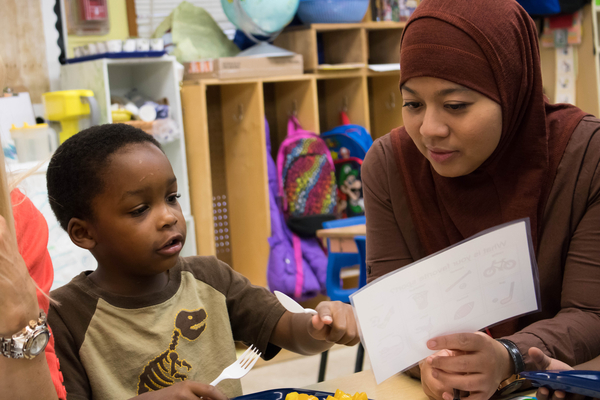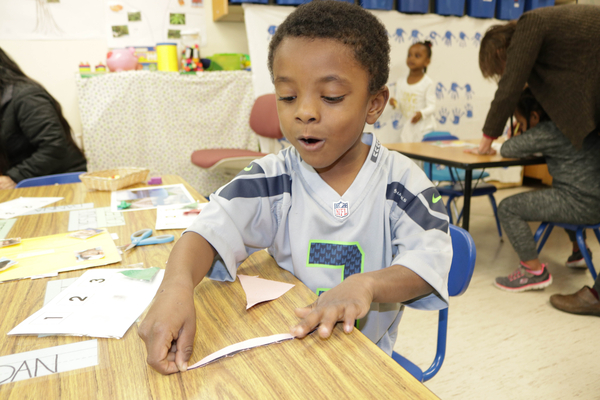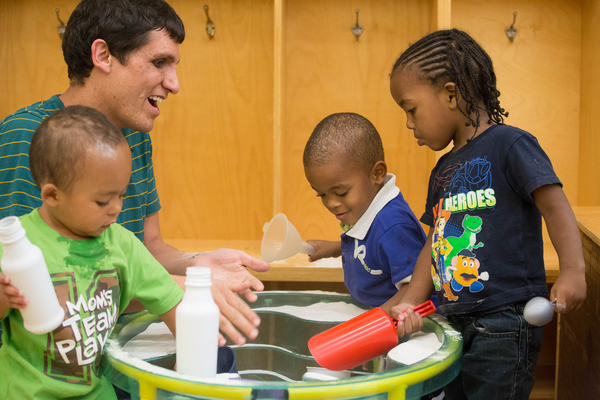 The expectations of others affect the educational success of African American boys. Families and education staff (e.g., teachers, family child care providers, home visitors) work together on setting appropriate and challenging learning expectations that are individually tailored to each child. Setting high expectations helps African American boys achieve success and see themselves as learners.
The expectations of others affect the educational success of African American boys. Families and education staff (e.g., teachers, family child care providers, home visitors) work together on setting appropriate and challenging learning expectations that are individually tailored to each child. Setting high expectations helps African American boys achieve success and see themselves as learners.
Characteristics of high-quality early childhood education for African American boys include staff holding high expectations for their success and being willing to highlight their strengths. To best support African American boys, education staff must challenge their personal biases and prejudices to make sure they have appropriate and meaningful expectations. This requires learning about and understanding the social, cultural, and political contexts in which young African American boys live. It requires engaging in critical reflection about teaching and home visiting practices and the ideas behind them. These are effective and necessary activities that can prepare education staff to support African American boys in meeting and exceeding expectations.
Why Communicating High Expectations for Learning Matters
In many ways, children will go as far as the adults in their lives believe that they can. High expectations play a part in a child’s success and what a child aspires to be.
- Applying a strength-based approach, caring support, and high expectations are essential for the school success of African American boys.
- The biggest obstacle to later academic success for African American boys is the adults who believe they cannot succeed and the behaviors that stem from that belief.
- One study showed that the impact of educator expectations in the early elementary school years was long-lasting.
- Minority boys in preschool to third-grade classrooms had the lowest performance in reading when their abilities were underestimated, and the greatest gains when their abilities were overestimated.
- African American boys are underrepresented in K-12 gifted education programs. The number is as high as 65% nationally; that means there are more than 125,000 African American males annually who are not receiving the education needed to reach their potential. They are not being given an appropriate level of academic challenge.
Reflect
 Think back to your childhood and the expectations of your family or educators. Think of a time when the expectations for you changed and became higher or lower.
Think back to your childhood and the expectations of your family or educators. Think of a time when the expectations for you changed and became higher or lower.
- How could you tell what their expectations were?
- Were the expectations clearly said or did you sense them?
- How did your behavior change when expectations were changed?
- Did these expectations and behaviors make you feel loved? Valued? Respected? Did they set you up for success? To thrive?
- Now think of African American boys you serve in your program. This might be through home visits and group socializations, in center-based classrooms, or in family child care settings.
- Think of a boy you don’t have high expectations for. How are your interactions affected? What is the basis of your expectation? Gender? Race? What might change your expectations?
- Think of another African American boy who you have high expectations for. How are your interactions affected? What is the basis of your expectation? Gender? Race? Reflect on what you see and hear through media about African American boys. Does this influence your expectations? What might change your expectations?
- How do you think your expectations affect the success of African American boys in your program?
Practices That Communicate High Expectations for Learning
 Set challenging but achievable goals for each African American boy that build on their strengths and interests and positively affirm their identities.
Set challenging but achievable goals for each African American boy that build on their strengths and interests and positively affirm their identities.
Add a “history and me” approach to your curriculum that focuses on the important discoveries and contributions of African American men and boys.
- For infants and toddlers, include board books and short story books with African American main characters that allow African American boys to see themselves reflected in a positive light.
- Ask the families about the type of music the child enjoys and the sounds that soothe the child. Incorporate these sounds into the environment. Include cultural items that are familiar to the children into classroom, family child care, and group socialization settings.
- For preschoolers, create opportunities to discuss and respond to storybooks about African American men and boys in various roles (community helpers, politicians, parenting, sports, science, activist, etc.)
Be a “warm demander.”
- Combine culturally responsive caring with high expectations.
- Use an encouraging tone, calm or smiling face, and language, such as, “I know you can do this. I’m here to help you if you need it.” This supports children of all ages.
Individualize support. Scaffold or offer just the right amount of support so that children are challenged and successful.
- Some children may need more attention while completing a daily routine or activity. For example, a toddler learning to put on their shoes might need an adult to stay close and offer encouragement. Others might need more support for learning certain concepts or skills. For example, for a child struggling to hold writing tools, give more writing opportunities throughout the day by using markers in dramatic play or chalk outside. Some children may need more challenging activities.
- Break challenging tasks into step-by-step activities. Make the first step something that children can already do and build up from there. For example, if an older toddler is learning to do simple puzzles, put in all pieces but one. Next time, put in all pieces but two — create opportunities for success and challenge.
- Observe learning environment needs. Some children may find it difficult to learn new skills in loud, busy environments. Can you create a quiet space? Some children may need a lot of room to move when learning a new skill. Is it OK to stand during a “sitting” activity if the child can learn best while standing?
Encourage children to keep trying at solving a problem.
- Be nearby, offer words of encouragement, help with part of the task, and ask questions to help the child think about how to solve the problem.
- Celebrate small progress and be attuned to signals of overwhelming frustration.
Extend the learning.
- Document and display children’s ideas, questions, and experiences with photographs, written descriptions, oral storytelling, or video. This gives children opportunities to see themselves as learners.
- For infants and toddlers, take photos of them learning, write about what they are doing, and display this learning in your classroom, family child care, or socialization group setting. Share this documentation with families too.
- For preschoolers, record their experiences and storytelling through their writing and pictures or record them telling a story with an audio or video recorder.
- Introduce and continue an ongoing story so preschool-age children can practice using their working memory to recall the characters and their actions.
When working with families or in home-based programs:
- Explore problem-solving opportunities for young children. For example, “I wonder how excited Jaden would be if he was able to put on his shoes by himself.”
- Brainstorm with parents to find different activities and household routines for their child that involve remembering and recalling information or following directions to complete tasks, and opportunities to explore and discover other ways of completing tasks. For toddlers, this can look like hanging their coat on a hook or finding a favorite book before reading together. Preschoolers can help with simple food preparation or get themselves dressed.
See It in Action
The videos in this playlist show examples of education staff having high expectations for children’s learning. As you watch the videos, try to identify the practices education staff use. Did they extend learning? Give hints and scaffold? What practices do you already use? Think about practices to implement in your learning environment. After watching the videos, you’ll have an opportunity to plan for, try out, and reflect on the strategy of communicating high expectations.
Loading...
Read Together
Read Together
View the transcript
High Expectations: Read Together
Teacher: "...Fish was the most beautiful fish in the...”
Child: Sea.
Teacher: "...in the sea, but he never played with any other...”
Child: He'd never play with the other fish.
Teacher: You...
Teacher: Turn your page. Okay, you got yours. Good job! "He went to the starfish for...”
Child: He went to the starfish for...
Teacher: For help.
Teacher: This is what?
Child: This is an octopus!
Teacher: That's an octopus. Whoa. "Suddenly...”
Child: Suddenly...
Teacher: "...the little blue fish was back.”
Child: The blue fish was back.
Teacher: "'Please,' he said...”
Child: "Please," he said.
Teacher: "...'could I have just one scale?'"
Child: "Could I have one scale?”
Teacher: Show me one finger. Good job, Darius! Ooh!
Teacher: Count those fish for me.
Child: 1.
Teacher: 1.
Child: 2.
Teacher: 2.
Teacher 2: Look.
Child: All of them are gone.
Teacher: All of them, gone?
Child: And then...
Child 2: [Screaming]
Teacher 2: Emma, you...
Child: All of the fish came back.
Teacher: All the fish came back!
Child: He got one of the scales. He got one of the scales. And he got one of the scales. And he got one of the scales.
Teacher: So did —
Child: And he got one of the scales.
Teacher: Did he give all his scales to some of his friends?
Child: Mm-hmm.
Teacher: Yes, he sure did.
Close
Understanding developmentally appropriate practice and having high expectations supports a child’s development. How is this educator fostering literacy skills in a developmentally appropriate and engaging way?
Try It!
Download the Try It! worksheet and choose one practice to focus on for one month. Use the prompts in the worksheet to thoughtfully plan how you will use the practice. The worksheet includes prompts for reflection after using the practice for one month.
 Deepen Your Learning
Deepen Your Learning
Use these resources to better understand young children’s brain development and ways their teachers and caregivers can support their growth in critical thinking and learning.
Connections to Head Start Standards, Frameworks, and Principles
This section explores Head Start practices that support the school readiness and success of young African American boys. Think about your program and your learning setting and consider ways you already do these practices and ways you can more closely align to improve your teaching practice.
Head Start Program Performance Standards
Head Start Early Learning Outcomes Framework
High expectations can be fostered through the learning and development goals in all domains of the ELOF: Approaches to Learning; Social and Emotional Development; Language and Literacy; Cognition; and Perceptual, Motor, and Physical Development. These two goals from the Social and Emotional domain are examples of how the ELOF reflects high expectations:
- IT-SE 12: Infants and toddlers show confidence in their abilities through relationships with others.
- P-SE 9: The child preschooler recognizes themselves as a unique individual having abilities, characteristics, emotions, and interests.
Learn more about these goals and practices in the ELOF Effective Practice Guides.
Multicultural Principles for Early Childhood Leaders
Implementation of the multicultural principles honors the cultural diversity of children, families, and communities served in Head Start programs.
Last Updated: February 21, 2024
 Deepen Your Learning
Deepen Your Learning The expectations of others affect the educational success of African American boys. Families and education staff (e.g., teachers, family child care providers, home visitors) work together on setting appropriate and challenging learning expectations that are individually tailored to each child. Setting high expectations helps African American boys achieve success and see themselves as learners.
The expectations of others affect the educational success of African American boys. Families and education staff (e.g., teachers, family child care providers, home visitors) work together on setting appropriate and challenging learning expectations that are individually tailored to each child. Setting high expectations helps African American boys achieve success and see themselves as learners. Think back to your childhood and the expectations of your family or educators. Think of a time when the expectations for you changed and became higher or lower.
Think back to your childhood and the expectations of your family or educators. Think of a time when the expectations for you changed and became higher or lower. Set challenging but achievable goals for each African American boy that build on their strengths and interests and positively affirm their identities.
Set challenging but achievable goals for each African American boy that build on their strengths and interests and positively affirm their identities.